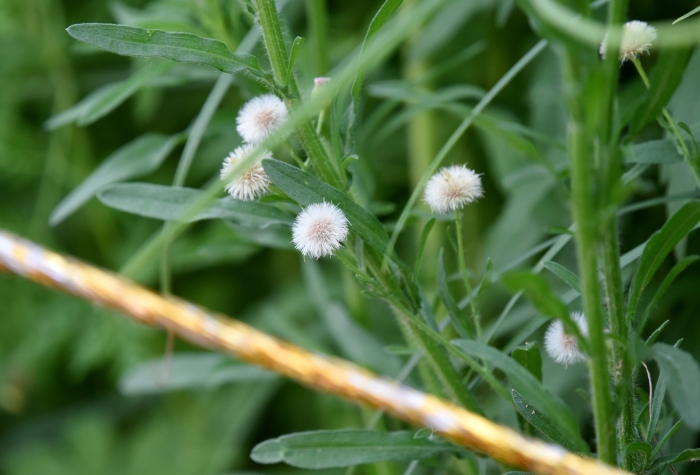Flax-Leaf Fleabane
(Erigeron bonariensis)
Flax-Leaf Fleabane (Erigeron bonariensis)
/
/

© Zinogre
CC BY-SA 4.0
Image By:
© Zinogre
Recorded By:
Copyright:
CC BY-SA 4.0
Copyright Notice:
Photo by: © Zinogre | License Type: CC BY-SA 4.0 | License URL: http://creativecommons.org/licenses/by-sa/4.0/ | Uploader: zinogre | Publisher: iNaturalist |






















Estimated Native Range
Summary
Erigeron bonariensis, commonly known as flax-leaf fleabane, is an annual herb that is considered a pioneer species, often one of the first to colonize disturbed soils. It is native to South America, particularly Argentina, and has naturalized in many regions worldwide, including North America, Europe, and Australia. This plant typically grows to a height of 1-3 feet (30-90 cm) and has a width of 0.5-2 feet (15-60 cm). Flax-leaf fleabane has a slender, erect stem with narrow, lance-shaped leaves and bears small white to pale lavender daisy-like flowers with yellow centers throughout the summer months. The flowers are modest in size but can be quite numerous, giving the plant a somewhat bushy appearance.
Flax-leaf fleabane is known for its rapid growth and ability to thrive in poor, compacted soils, which makes it useful for erosion control or as a temporary ground cover in restoration projects. It is also used in urban environments for its adaptability and low maintenance. In cultivation, it prefers full sun to part shade and can tolerate a range of soil types, though it performs best in well-drained soils. It requires minimal water once established. There are no popular garden cultivars of this species due to its invasive nature. Gardeners should be cautious as it can become weedy and spread aggressively, outcompeting native plants. It may also be subject to powdery mildew and rust diseases in humid conditions.CC BY-SA 4.0
Flax-leaf fleabane is known for its rapid growth and ability to thrive in poor, compacted soils, which makes it useful for erosion control or as a temporary ground cover in restoration projects. It is also used in urban environments for its adaptability and low maintenance. In cultivation, it prefers full sun to part shade and can tolerate a range of soil types, though it performs best in well-drained soils. It requires minimal water once established. There are no popular garden cultivars of this species due to its invasive nature. Gardeners should be cautious as it can become weedy and spread aggressively, outcompeting native plants. It may also be subject to powdery mildew and rust diseases in humid conditions.CC BY-SA 4.0
Plant Description
- Plant Type: Herb
- Height: 0.25-1.1 feet
- Width: 1-1.25 feet
- Growth Rate: Rapid
- Flower Color: White, Purple
- Flowering Season: Summer, Fall
- Leaf Retention: Deciduous
Growth Requirements
- Sun: Full Sun
- Water: Medium
- Drainage: Fast
Common Uses
Border Plant, Low Maintenance
Natural Habitat
Native to South America, particularly Argentina
Other Names
Common Names: Flaxleaf Fleabane, Hairy Horseweed, Asthma Weed, Zebe Coq D’Inde (Lesser Antilles), Wavy-Leaf Fleabane
Scientific Names: , Erigeron bonariensis, Conyza bonariensis, Conyza bonariensis, Conyza bonariensis f. bonariensis, Conyza bonariensis var. leiotheca, Conyza chenopodioides, Conyza crispa, Conyza crispa, Conyza hispida
GBIF Accepted Name: